Home >> Optics, the eye
biology |
||
Eye biology
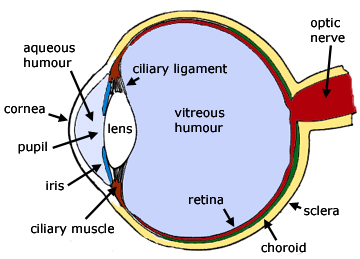
retina - a light sensitive region on the rear of the inner surface of the eyeball.
accommodation - the ability of the eye to produce a focussed image on the retina. This is done by altering the shape of the eye-lens by muscle in the shape of a ring, called the ciliary muscle. The ciliary ligament transfers force between the muscle and the lens.
iris - a ring of muscle controlling the amount of light entering the eye.
lens - made of clear cartilage. In old age the lens can become opague. In a simple procedure it can be replaced with a plastic lens.
cornea - front part of the eye. Most of the deviation of light coming from an object occurs at the air/cornea boundary. Old age/disease can cause the cornea to become fogged, eventually causing blindness. Transplants from cadavers can remedy this.
pupil - the space inside the iris. This appears black because it leads into the eyeball. Inside the eyeball is caverness and dimly lit from light entering.
humours - the aqueous and vitreous humours are clear liquids within the eye with similar refractive indices.
aqueous humour (1.33 )
vitreous humour (1.34 )
eye lens (1.41 )
cornea ( 1.38 )
Visual Angle
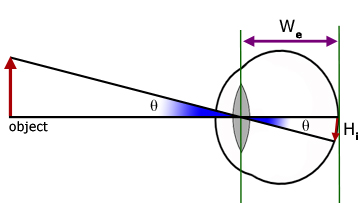
The size of objects perceived by the eye depends on the size of their image on the retina.
Suppose an object subtends an angle θ at the eye, producing an image of height Hi on the retina.
If We is the width of the eyeball between lens and retina, then for small angles, to a good approximation:
![]()
Angular Magnification (magnifying power)
This is used in optical instruments - microscopes, telescopes.
Angular magnification is the ratio of the angle subtended at the eye by the image (βo), to the angle subtended by the object (αo).
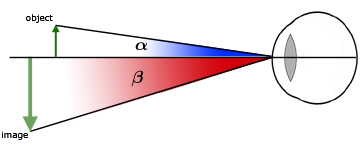
![]()
Near Point
The near point (D) is the closest distance infront of the eye where a positioned object is in focus. It is sometimes referred to as 'the least distance of distinct vision'.
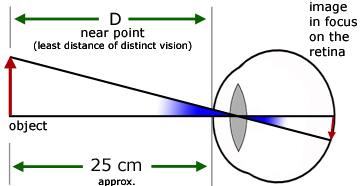
The near point varies from person to person, but a good average is 25 cm.
Short Sight (Myopia)
As the name implies, a person with 'short sight' can see objects close up, but not in the distance.
Short sight is a result of an abnormally long eyeball or the eye lens being too strong. The consequence is that the image of a distant object is formed infront of the retina. The resulting image actually reaching the retina is therefore out of focus.
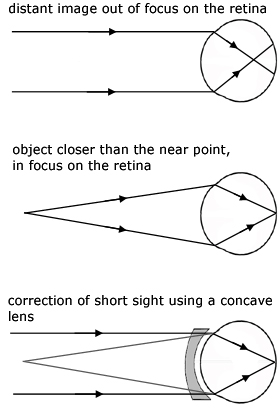
Correction of short sight is by concave lens. A concave lens is a diverging lens. So the effect is to push the image back towards the surface of the retina, where it will be perceived as in focus.
Long Sight (Hypermetropia)
As the name implies, a person with 'long sight' can see objects far away , but not close up.
Long sight is a result of an abnormally short eyeball or the eye lens being too weak. The consequence is that the image of a distant object is formed behind the retina. The resulting image perceived on the retina is therefore out of focus.
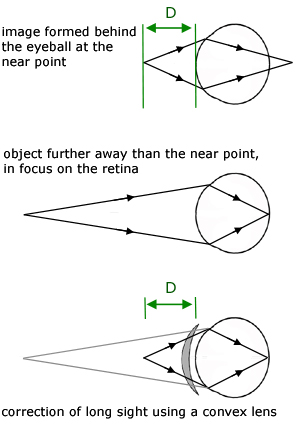
Correction of long sight is by convex lens. A convex lens is a converging lens. So the effect is to pull the image back from behind the eyeball towards the surface of the retina, where it will be perceived as in focus.
this week's promoted video
[ About ] [ FAQ ] [ Links ] [ Terms & Conditions ] [ Privacy ] [ Site Map ] [ Contact ]
